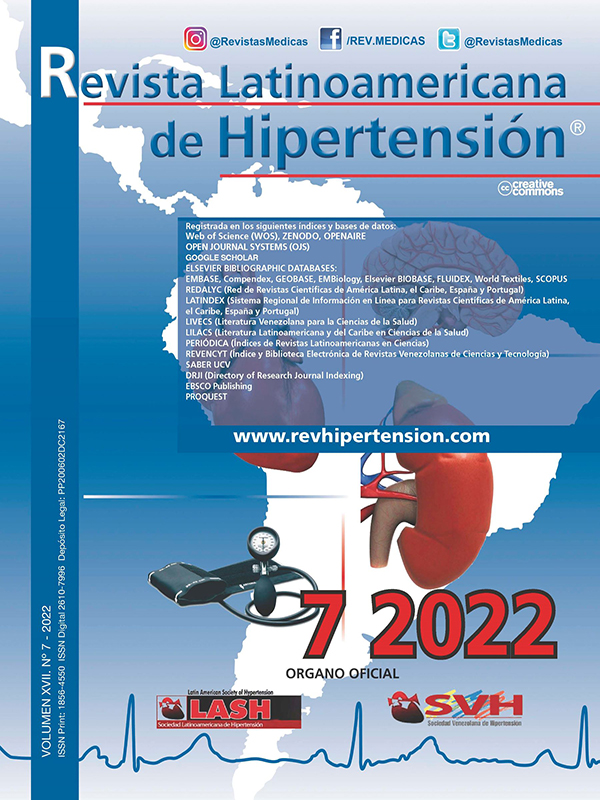Endothelial dysfunction and atherosclerosis: Pathophysiologic link
Resumen
La ateroesclerosis es la principal precursora de la enfermedad cardiovascular (ECV), y dada su importancia epidemiológica, se ha incrementado el interés en determinar los mecanismos moleculares subyacentes con la finalidad de establecer nuevas estrategias terapéuticas. Gracias a la localización estratégica y las funciones que ejercen, las células endoteliales se han establecido como el eslabón perdido entre los factores de riesgo cardiovascular y el desarrollo de la ateroesclerosis. Esto se debe a elementos como la sobreproducción de especies reactivas de oxígeno, mayor estrés oxidativo y disfunción endotelial. Además, se ha demostrado que la disfunción endotelial precede el desarrollo de placas ateroscleróticas detectables y predice el pronóstico de la enfermedad, considerándose como un evento fundamental temprano en el proceso aterogénico. Estos componentes representan dianas invaluables para la investigación a futuro. El objetivo de la presente revisión es describir el conocimiento actual en relación a los mecanismos moleculares subyacentes a la ateroesclerosis y la disfunción endotelial y su relación con la ECV.
Descargas
Citas
Cassar A, Holmes DR, Rihal CS, Gersh BJ. Chronic coronary artery disease: diagnosis and management. Mayo Clin Proc. diciembre de 2009;84(12):1130-46.
Writing Group Members, Mozaffarian D, Benjamin EJ, Go AS, Arnett DK, Blaha MJ, et al. Heart Disease and Stroke Statistics-2016 Update: A Report From the American Heart Association. Circulation. 26 de enero de 2016;133(4):e38-360.
Chhabra N. Endothelial dysfunction – A predictor of atherosclerosis. Internet Journal of Medical Update. 2009;4(1):33-41.
Halcox JPJ, Schenke WH, Zalos G, Mincemoyer R, Prasad A, Waclawiw MA, et al. Prognostic value of coronary vascular endothelial dysfunction. Circulation. 6 de agosto de 2002;106(6):653-8.
Cai H, Harrison DG. Endothelial dysfunction in cardiovascular diseases: the role of oxidant stress. Circ Res. 10 de noviembre de 2000;87(10):840-4.
Reddy KG, Nair RN, Sheehan HM, Hodgson JMcB. Evidence that selective endothelial dysfunction may occur in the absence of angiographic or ultrasound atherosclerosis in patients with risk factors for atherosclerosis. Journal of the American College of Cardiology. marzo de 1994;23(4):833-43.
Davignon J, Ganz P. Role of endothelial dysfunction in atherosclerosis. Circulation. 15 de junio de 2004;109(23 Suppl 1):III27-32.
Zeiher AM, Drexler H, Wollschläger H, Just H. Endothelial dysfunction of the coronary microvasculature is associated with coronary blood flow regulation in patients with early atherosclerosis. Circulation. noviembre de 1991;84(5):1984-92.
Drexler H. Factors involved in the maintenance of endothelial function. Am J Cardiol. 19 de noviembre de 1998;82(10A):3S-4S.
Ludmer PL, Selwyn AP, Shook TL, Wayne RR, Mudge GH, Alexander RW, et al. Paradoxical vasoconstriction induced by acetylcholine in atherosclerotic coronary arteries. N Engl J Med. 23 de octubre de 1986;315(17):1046-51.
Celermajer DS, Sorensen KE, Bull C, Robinson J, Deanfield JE. Endothelium-dependent dilation in the systemic arteries of asymptomatic subjects relates to coronary risk factors and their interaction. J Am Coll Cardiol. 15 de noviembre de 1994;24(6):1468-74.
Daugherty A, Rateri DL, Lu H, Inagami T, Cassis LA. Hypercholesterolemia Stimulates Angiotensin Peptide Synthesis and Contributes to Atherosclerosis Through the AT1A Receptor. Circulation. 21 de diciembre de 2004;110(25):3849-57.
Matsuura E, Hughes GRV, Khamashta MA. Oxidation of LDL and its clinical implication. Autoimmun Rev. julio de 2008;7(7):558-66.
Wassmann S, Hilgers S, Laufs U, Böhm M, Nickenig G. Angiotensin II type 1 receptor antagonism improves hypercholesterolemia-associated endothelial dysfunction. Arterioscler Thromb Vasc Biol. 1 de julio de 2002;22(7):1208-12.
Vladimirova-Kitova L, Deneva T, Angelova E, Nikolov F, Marinov B, Mateva N. Relationship of asymmetric dimethylarginine with flow-mediated dilatation in subjects with newly detected severe hypercholesterolemia. Clin Physiol Funct Imaging. noviembre de 2008;28(6):417-25.
De Gennaro Colonna V, Bianchi M, Pascale V, Ferrario P, Morelli F, Pascale W, et al. Asymmetric dimethylarginine (ADMA): An endogenous inhibitor of nitric oxide synthase and a novel cardiovascular risk molecule. Medical science monitor: international medical journal of experimental and clinical research. 2009;15(4):RA91-RA10.
Veresh Z, Racz A, Lotz G, Koller A. ADMA impairs nitric oxide-mediated arteriolar function due to increased superoxide production by angiotensin II-NAD(P)H oxidase pathway. Hypertension. noviembre de 2008;52(5):960-6.
Smirnova IV, Sawamura T, Goligorsky MS. Upregulation of lectin-like oxidized low-density lipoprotein receptor-1 (LOX-1) in endothelial cells by nitric oxide deficiency. Am J Physiol Renal Physiol. julio de 2004;287(1):F25-32.
Norata GD, Catapano AL. Molecular mechanisms responsible for the anti-inflammatory and protective effect of high-density lipoprotein on the endothelium. High blood pressure & cardiovascular prevention: the official journal of the Italian Society of Hypertension. 2007;14(1):21-31.
Norata G, Callegari E, Inoue H, Catapano A. HDL3 Induces Cyclooxygenase-2 Expression and Prostacyclin Release in Human Endothelial Cells Via a p38 MAPK/CRE-Dependent Pathway: Effects on COX-2/PGI-Synthase Coupling. Arteriosclerosis, thrombosis, and vascular biology. 1 de junio de 2004;24:871-7.
Chikani G, Zhu W, Smart EJ. Lipids: potential regulators of nitric oxide generation. Am J Physiol Endocrinol Metab. septiembre de 2004;287(3):E386-389.
Virdis A. Endothelial Dysfunction in Obesity: Role of Inflammation. High Blood Press Cardiovasc Prev. junio de 2016;23(2):83-5.
Hartell NA, Archer HE, Bailey CJ. Insulin-stimulated endothelial nitric oxide release is calcium independent and mediated via protein kinase B. Biochem Pharmacol. 1 de marzo de 2005;69(5):781-90.
Böger RH. The emerging role of asymmetric dimethylarginine as a novel cardiovascular risk factor. Cardiovasc Res. 1 de octubre de 2003;59(4):824-33.
Tesfamariam B, Cohen RA. Free radicals mediate endothelial cell dysfunction caused by elevated glucose. Am J Physiol. agosto de 1992;263(2 Pt 2):H321-326.
Zou M-H, Shi C, Cohen RA. Oxidation of the zinc-thiolate complex and uncoupling of endothelial nitric oxide synthase by peroxynitrite. J Clin Invest. marzo de 2002;109(6):817-26.
Münzel T, Daiber A, Ullrich V, Mülsch A. Vascular consequences of endothelial nitric oxide synthase uncoupling for the activity and expression of the soluble guanylyl cyclase and the cGMP-dependent protein kinase. Arterioscler Thromb Vasc Biol. agosto de 2005;25(8):1551-7.
Messner B, Bernhard D. Smoking and Cardiovascular Disease. Arteriosclerosis, Thrombosis, and Vascular Biology. 1 de marzo de 2014;34(3):509-15.
Guzik TJ, Touyz RM. Oxidative Stress, Inflammation, and Vascular Aging in Hypertension. Hypertension. octubre de 2017;70(4):660-7.
Descargas
Publicado
Versiones
- 2023-04-16 (2)
- 2023-02-11 (1)

